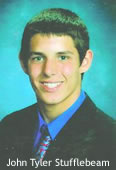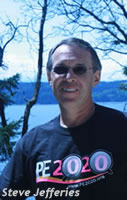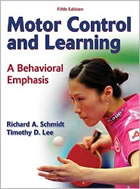Tyler
Stufflebeam
1990 - 2011

Physical Education Major, Slippery
Rock University, PA
Tribute
|
CORRECTION: Last month we incorrectly reported
that physical education classes would no longer
be required in Texas high schools. Dolly Lambdin
has informed us that it was health education
that was eliminated as a requirement and that
students in Texas would still be required
to take one year of physical education. Apologies
for the error.
THE YEAR AHEAD IN PHYSICAL EDUCATION
Optimism, according to Merriam-Webster,
is "an inclination … to anticipate
the best possible outcome." Hoping for
the best is good. How depressing it would
be to surround ourselves with people who routinely
anticipate the worst? However, a sense of
reality is probably also a good thing, and
this academic year it would be wise to attend
to what author Jim
Collins referred to in his book Good
to Great as the "brutal facts."
Looking ahead to the upcoming school year
we all hope that it’s going to be a
good one for physical education. Unfortunately,
a closer look at what’s happening in
the world around us does not offer much comfort.
Consider the following:
Economic Stagnation
Even the most optimistic projections don't
anticipate our depressed economy recovering
for several years. Some writers (see Aftershock:
The Next Economy and America's Future
by Robert Reich), are far less optimistic
and question whether middle class lifestyles
will ever return to "normal." For
sure, unemployment and incomes are not likely
to change soon, which means that local community
funding for things like schools will remain
depressed. Even worse, if funding continues
to decrease, school districts will face more
budget shortfalls and be forced to consider
more program and position cuts.
Poverty Levels Worsening and Wealth
Gap Widening
The Annie
E. Casey Foundation recently reported
that 1 in 5 children live in poverty, and
almost half live close to poverty. These children
struggle in school, are more likely to be
held back, and are less likely to later get
a job. Poorer children are invariably less
healthy which author Charles Basch believes
largely accounts for them doing worse in school
(see Healthier
Students are Better learners: A Missing Link
in School Reforms to Close the Achievement
Gap).
In today's depressed economy it’s hard
to imagine a turn around in poverty. And if
it doesn't, we can anticipate an ongoing decrease
in skilled workers, increased demands for
social services, and higher crime rates. Simultaneously,
the division between the have's and have not's
is widening. One percent of the US population
now owns approximately 40% of the nation's
wealth.
Workforce Globalization
Assuming that at least some time in the next
few years the US economy recovers, we face
increased global competition from China and
India, the world's largest and fastest developing
countries. Each already has a population approximately
four times the US, and a population focused
on developing the skills needed in our 21st
century knowledge-information age. What does
this mean for physical education? Once again,
it challenges our existence because it threatens
employment opportunities for local communities,
which affects funding for local schools. When
schools are under budgetary pressure, so too
is physical education.
Failing Schools
But here's the crux of the issue. It's estimated
that by 2018, the US will only have about
¼ of the qualified workers needed for
the available high skilled, high paying jobs.
In contrast to our parents' time, most future
jobs will require some college level education.
Currently, only about 2/3 of our students
graduate from high school. An estimated 7000
students drop out of school daily! Barely
½ of African Americans and Latino students
graduate from high school.
School reform proponents continue to point
out the inadequacies of a school system largely
unchanged since it was created during the
19th century industrial revolution. And today,
because of the obvious economic consequences,
reformers have the ears of political decision
makers. Something has to change in the way
we educate our children. And according to
Bill Gates it is already occurring at "blinding
speed."
In all likelihood, most of the preceding
information was not on your mind when you
thought about the upcoming year in physical
education. You were probably more focused
on gym space, equipment, and curriculum issues.
But this is the danger. Thinking only about
issues within our profession ignores
the growing threat outside. Public
education will be reformed sooner
rather than later. If nations can undergo
the changes we've witnessed in the past few
months, so too can our schools. And when schools
change – like it or not - so too will
physical education.
It's easy to assume changes will miss you.
They won't. It's just a question of time.
Weekly news feeds report school physical education
programs being reduced or cut, and efforts
to allow more waivers. The good news is that
sometimes there are reports of new and innovative
ways that physical educators are changing
to make their programs more relevant. While
it's unlikely there is one best solution,
it's clear that physical education needs to
be able to show its relevance in reform efforts.
Isolating ourselves in the gym, assuming that
others will value and protect us, is a recipe
for disaster. And as many physical educators
around the country have sadly already discovered,
cuts can come quickly and unexpectedly. By
then it is often too late.
 One
of the outcomes of this past year's PE2020
initiative was a belief that we need to do
more to integrate our programs within the
school and within the local community. What
this means in your setting will differ from
location to location. But I'm firmly convinced
that this year it's vital for physical educators
to commit themselves to being part of any
discussion on school change. Congress moves
closer to revisiting No
Child Left Behind. All but four states
have adopted the Common
Core Standards (within which physical
education is not mentioned). We all need to
be prepared to show how physical education
can play a vital part in the emerging goals
of a 21st century public education. One
of the outcomes of this past year's PE2020
initiative was a belief that we need to do
more to integrate our programs within the
school and within the local community. What
this means in your setting will differ from
location to location. But I'm firmly convinced
that this year it's vital for physical educators
to commit themselves to being part of any
discussion on school change. Congress moves
closer to revisiting No
Child Left Behind. All but four states
have adopted the Common
Core Standards (within which physical
education is not mentioned). We all need to
be prepared to show how physical education
can play a vital part in the emerging goals
of a 21st century public education.
Finally, this month's edition of pelinks4u
is dedicated to the memory of (John)
Tyler Stufflebeam. Tyler, a physical
education major at Slippery Rock University,
PA, was killed in an automobile accident on
September 10th.
Tyler was active in student affairs, helped
coach youth football and wrestling, and was
an exemplary physical educator. He hunted,
ran, canoed and was an avid Pittsburgh Steelers
fan. He will be greatly missed by his parents,
brothers, relatives, and his SRU physical
education student and faculty friends and
colleagues. Our condolences to all.
Steve
Jefferies, publisher pelinks4u
|
















 One
of the outcomes of this past year's PE2020
initiative was a belief that we need to do
more to integrate our programs within the
school and within the local community. What
this means in your setting will differ from
location to location. But I'm firmly convinced
that this year it's vital for physical educators
to commit themselves to being part of any
discussion on school change. Congress moves
closer to revisiting
One
of the outcomes of this past year's PE2020
initiative was a belief that we need to do
more to integrate our programs within the
school and within the local community. What
this means in your setting will differ from
location to location. But I'm firmly convinced
that this year it's vital for physical educators
to commit themselves to being part of any
discussion on school change. Congress moves
closer to revisiting